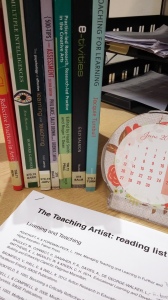 I’ve spent the morning looking at our PGCert Moodle pages, and viewing DVDs of the Thursday evening online sessions that I haven’t been able to “attend” in person. (There were actually seven sessions. I’ve reached the fifth one so far.) And I’ve taken a closer look at the course reading-list with all the online links. That was quite informative. Although my absence of “click-throughs” suggests I may not have engaged with the materials provided, in actual fact I viewed quite a few of them when I did the first part of the course two years ago, and they’re listed in my bibliography as evidence of that. But of course, the click-throughs would have registered on the 2014 Moodle rather than the 2015-16 Moodle pages. Confused? Please don’t be!
I’ve spent the morning looking at our PGCert Moodle pages, and viewing DVDs of the Thursday evening online sessions that I haven’t been able to “attend” in person. (There were actually seven sessions. I’ve reached the fifth one so far.) And I’ve taken a closer look at the course reading-list with all the online links. That was quite informative. Although my absence of “click-throughs” suggests I may not have engaged with the materials provided, in actual fact I viewed quite a few of them when I did the first part of the course two years ago, and they’re listed in my bibliography as evidence of that. But of course, the click-throughs would have registered on the 2014 Moodle rather than the 2015-16 Moodle pages. Confused? Please don’t be!
I had made up my mind that I’d be on the lookout for information about assessment and feedback today. Going through our course-materials, I soon realised that the subject can be looked at in two ways because we, the students, have to undergo assessment and receive feedback, every bit as much as we have to know the best way (a) to ascertain whether our students have learned what we set out to teach them, and (b) to give them effective feedback. Jamie Mackay talked to us about assessment modes and criteria in our second online Teaching Artist session, but obviously this is a topic that is interwoven throughout the course. Thus, in the third session, we learned about assessment in teaching that has been designed using constructive alignment principles: the intended learning experiences should be measurable against the learning outcomes, so that the teacher can assess whether the ‘alignment’ has effectively led to the desired outcomes.
In the fourth online session (28th January 2016), Rachel reminded us that the teacher should review results in an ongoing process so that he/she can determine whether the teaching has been effective and whether modifications or adjustments are required in subsequent lesssons – this is also part of practice-based research, so we’ll need to consider it when we design our projects. Already, I have tried to elicit feedback, whether from the course-leader, the students, or both, in training sessions that I have given, because my research project will focus on how performing arts students can best be engaged in library/information type instruction sessions. Clearly, if I can identify best practice, then it will give me the best chance of designing learning that students will benefit from.
In the same session, Jamie led a discussion about grading compared to appreciation or guidance, and participants were encouraged to consider occasions when they had received bad, or good feedback, also discussing when each form of feedback was most useful – grading against criteria, showing appreciation to give support and encouragement, or (possibly a little while later), going on to give guidance to help establish the way forward, or the next steps a student might take in their learning journey. After giving a grading, a student might need guidance as to how they can go on to improve their performance. After a performance, a student might initially just need appreciation and a bit of praise, followed by guidance about aspects that merited further work.
It was noted that there was no point in praising if praise was not merited, if the student was showing a poor or disrespectful attitude, or if improvement was obviously needed. The important thing is to focus on the work not the person. The work may have been poor – but the student shouldn’t be demolished in the telling.
The same evening, Mary talked about evaluating teaching using the ‘critical incident questionnaire’, and recommended Stephen Brookfield’s book, Becoming a Critically Reflective Teacher – again, it’s in the Whittaker Library. Brookfield suggests that when reflecting on one’s practice, one can use four ‘lenses’ – ie, four different sources of information, to evaluate one’s teaching: one’s own observation, peer feedback, student feedback, or by reading the ‘scholarly literature’. (Mary’s Powerpoint slide 2). It is crucial to find out if your teaching is effective, and what the students feel about your teaching – good points and bad. For that, you need feedback.
I devised a very simple feedback form for my Scottish music sessions just before Christmas, as I had done for the postgrads when I did a bibliographic referencing session a year or two ago. In this, I just asked what they liked; disliked; and would have liked more of. My analysis of the Scottish music class results can be read in my Portfolio for 2015-16. Brookfield’s critical incident questionnaire asks five questions compared to my three (Mary’s Powerpoint slide 7):-
- When in the session did the student feel most and/or least engaged? (a bit like my first and second questions, except that I used the word “enjoyed”)
- What action did anyone take that was most helpful/affirming?
- Similarly, what was least helpful/affirming?
- What was the most important information learned? (this is subtly different from my question about what was most enjoyed!)
- Were there any questions/suggestions about the class? (similar to my “what would you like more of?” question)
Mary explained that an analysis of the answers would help us identify major themes felt by several students, and would help us plan future sessions. I certainly found this to be the case in my own analysis.
The question of assessment and its purpose was continued in the fifth online session (19th February 2016), when participants were reminded that assessment is also important to learners, so that they can see themselves making progress – this supports the learning process and lets them see where improvements or other readjustments might need to be made. Students need to know what was good, but also where there might be gaps, or what needs to be done next or followed up. This is formative assessment, whilst a mark or grade is summative, sets standards, and might be necessary before moving on to a higher level, for example.
 I would like to look at the Brookfield book that Mary recommended, but I have also borrowed Race, Brown and Smith’s 500 Tips on Assessment, which looks an approachable book and might give me some more ideas:-
I would like to look at the Brookfield book that Mary recommended, but I have also borrowed Race, Brown and Smith’s 500 Tips on Assessment, which looks an approachable book and might give me some more ideas:-
- Brookfield, Stephen, Becoming a Critically Reflective Teacher (San Francisco: Jossey-Bass, 1995)
- Race, Phil, Sally Brown and Brenda Smith, 500 Tips on Assessment, 2nd ed. (London: Routledge Falmer, 2005)
